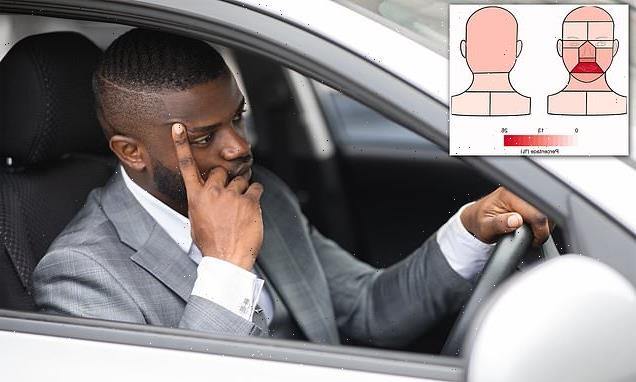Hands on the wheel! Drivers pick, rub and scratch their face 26 TIMES an hour on average – potentially spreading germs and infection, study warns
- Researchers analysed 31 hours of driving footage from 36 drivers
- They found that drivers touched their face 26.4 times per hour on average
- 42.5% of touches were to the inner lining of the lips, nostrils and eyes
- Previous research has shown that touching your face can increase the risk of spreading germs and infections, including Covid-19
Amid the Covid-19 pandemic, we’ve all regularly been told to avoid touching our faces, but it seems that many of us can’t resist – particularly while in the car.
New research has revealed that drivers pick, rub and scratch their face 26 times an hour on average.
Worryingly, researchers from the University of Nottingham say that the behaviour could lead to the spread of germs and infections, including Covid-19.
Dr David R Large, co-author of the study, said: ‘Face-touching behaviours, present a transmission risk to the driver, particularly if that vehicle is shared or occupied by multiple parties, and where hand hygiene is poor.
‘By scratching their nose or rubbing their eye, for example, the driver may inadvertently transfer viruses or another hazardous foreign substance – acquired from a contaminated vehicle control or surface while driving or prior to entering the vehicle – to their face.’
New research has revealed that drivers pick, rub and scratch their faces26 times an hour on average (stock image)
Why should you avoid touching your face?
Previous research has shown that touching your face can increase the risk of spreading germs and infections.
The Association for Professionals in Infection Control and Epidemiology explained: ‘Respiratory infections, like pneumonia, flu, or COVID-19, can spread through droplets in the air when a sick person coughs, sneezes, or talks near you.
‘They can also spread by direct contact with bacteria, viruses, and other disease-causing germs.
‘When we touch people who are sick, or touch dirty surfaces, we contaminate our hands with germs. We can then infect ourselves with those germs by touching our face.’
In the study, the team analysed 31 hours of driving footage from 36 drivers, and found that drivers touched their face 26.4 times per hour on average, with each touch lasting nearly four seconds.
The face itself was touched most (79.6 per cent), followed by the hair (10 per cent), neck (8.6 per cent) and shoulders (1.7 per cent).
On the face, 42.5 per cent of touches were to the inner lining of the lips, nostrils and eyes, known as the mucous membranes, with fingertips and thumbs most commonly used.
However, drivers were less likely to touch their faces during episodes of ‘high workload’ – including when they were preparing to change lane or turn.
‘Driving as a task already has a multitude of physical touch points and requires the manual manipulations of various control devices,’ Dr Large said.
‘Understanding how these are punctuated by intrinsic human behaviours such as face touching, and the potential impact these have on health and hygiene, and task-related factors, such as function and performance, is clearly important.’
Worryingly, previous research has shown that touching your face can increase the risk of spreading germs and infections, including Covid-19.
The Association for Professionals in Infection Control and Epidemiology explained: ‘Respiratory infections, like pneumonia, flu, or COVID-19, can spread through droplets in the air when a sick person coughs, sneezes, or talks near you.
‘They can also spread by direct contact with bacteria, viruses, and other disease-causing germs.
‘When we touch people who are sick, or touch dirty surfaces, we contaminate our hands with germs. We can then infect ourselves with those germs by touching our face.’
The researchers hope the findings could help in the development of more touchless interfaces within cars.
They suggest this could include hand or facial gestures to change radio station or adjust the air conditioning.
Finian Ralph, co-author of the study, added that exisiting driver monitoring systems that analyse blink rates and head nodding to detect fatigue, could also prove useful.
‘The driver could be alerted if the system detects unusual behaviour indicative of face-touching, or be provided with a pre-emptive warning, for example, during periods of low driving workload when results from our study indicate that face-touching may be higher – although it is recognised that such warnings could become annoying,’ he explained.
Penalties for using your phone while driving
It’s estimated that 660,000 drivers are using an electronic device while driving at any given time during the day.
That prevalence is where a lot of the danger lies. With so many people on the road using highly distracting devices, the potential for accidents—and thus injuries and fatalities—is incredibly high.
There can be lethal consequences or the chance of injuring someone are the biggest risk factors with texting and driving, but there are other risks as well.
You can get 6 penalty points and a £200 fine if you use a hand-held phone when driving.
Newly qualified drivers could be made to retake their driving test the first time they are caught.
Source: Read Full Article

